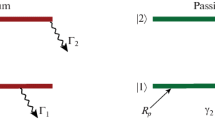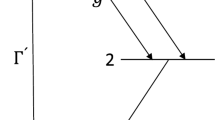Abstract
The thermodynamic properties of the laser distribution in the steadily oscillating state are investigated to determine the minimum characteristic of the entropy production. First, the laser Langevin equation for five random variables is treated in the light of the stochastic calculus to deduce the photon-number rate equationn = − C+(n − nc) + [A/(1 + sn)](n−nA), where nn and n4 are the two constants of the fluctuation attributed to the noise forces subject to the usual fluctuation-dissipation theorem, withn 4 < 0 for the inverted atomic population. We then combine the dynamics of the lasing mode with a model open system of the Lebowitz type with two reservoirs for which the entropy productionσ(p) is expressed and made subject to a variational principle: The modified variation scheme, the same as Prigogine's local potential method, is shown to give the exact lasing distributionp as the optimum between two distributions of thermal type with temperatures far from each other.
Similar content being viewed by others
References
H. Haken, Laser Theory, inEncyclopedia of Physics, Vol. XXV/2c (New York, 1970).
W. H. Louisell,Quantum Statistical Properties of Radiation (Wiley, New York, 1973).
M. Sargent, M. O. Scully, and W. E. Lamb,Laser Physics, Addison-Wesley, 1974.
K. Hepp and E. H. Lieb,Helv. Phys. Acta 46:573 (1973); inLecture Notes in Physics, No. 38 (Springer Verlag, 1975), p. 178.
E. H. Lieb,Physica 73:226 (1974).
K. Hepp,Acta Physica Austriaca, Suppl. XI 1973:475; inLecture Notes in Physics, No. 39 (Springer Verlag, 1975), p. 138;Z. Phys. B 20:53 (1975).
P. Glansdorff and I. Prigogine,Thermodynamic Theory of Structure, Stability and Fluctuations (Wiley-Interscience, London, 1971).
R. Graham, inCoherence and Quantum Optics, L. Mandel and E, Wolf, eds. (Plenum Press, New York, 1973), p. 851; inSpringer Tracts in Modern Physics, No. 66 (1973).
K. Itô,Applied Math. Optimization 1:374 (1975); inLecture Notes in Physics, No. 39 (Springer Verlag, 1975), p. 218.
R. S. Ingarden and A. Kossakowski,Ann. Phys. (N.Y.) 89:451 (1975).
F. Haake,Springer Tracts in Modern Physics, No. 66 (1973).
M. O. Scully and W. E. Lamb, Jr.,Phys. Rev. 159:208 (1967).
P. G. Bergmann and J. L. Lebowitz,Phys. Rev. 99:578 (1955).
J. L. Lebowitz,Phys. Rev. 114:1192 (1959);Phys. Rev. 128:1945 (1962).
H. Spohn,J. Math. Phys. 19:1277 (1978); H. Spohn and J. L. Lebowitz,Adv. Phys. Chem. (1979).
H. Hasegawa,Prog. Theor. Phys. 58:128 (1977).
I. Prigogine,Introduction to Thermodynamics of Irreversible Processes, 3rd ed. (Interscience, New York, 1967).
N. G. van Kampen,Adv. Chem. Phys. 34:245 (1976).
W. Horsthemke and L. Brenig,Z. Phys. B 27:341 (1977).
H. Statz and G. de Mars,Quantum Electronics, C. H. Towns, ed. (Columbia Univ. Press, New York, 1960), p. 530.
R. L. Stratonovich,Conditional Markov Processes and their Application to Optimal Control (Elsevier, New York, 1968).
E. Wong and M. Zakai,Ann. Math. Statistics 36:1560 (1965).
R. Kubo and N. Hashitsume,Prog. Theor. Phys. Suppl. 46:210 (1970).
R. Bonifacio, P. Schwendimann, and F. Haake,Phys. Rev. A 4:302 (1971).
E. Nelson,Dynamical Theory of Brownian Motion (Princeton Univ. Press, 1967).
L. Onsager,Phys. Rev. 37:405 (1931).
P. Glansdorff and I. Prigogine,Physica 30:351 (1964).
I. Prigogine and P. Glansdorff,Physica 31:1242 (1965);Nonequilibrium Thermodynamics Variational Techniques and Stability (University of Chicago Press, Chicago, 1965).
M. Gronchi and L. A. Lugiato,Phys. Rev. A 13:830 (1976).
L. A. Lugiato,Physica 81A:565 (1975).
For a summary, see H. Hasegawa and T. Nakagomi,Suppl. Prog. Theor. Phys. 64:321 (1978).
Author information
Authors and Affiliations
Rights and permissions
About this article
Cite this article
Hasegawa, H., Nakagomi, T. Semiclassical laser theory in the stochastic and thermodynamic frameworks. J Stat Phys 21, 191–214 (1979). https://doi.org/10.1007/BF01008698
Received:
Issue Date:
DOI: https://doi.org/10.1007/BF01008698




